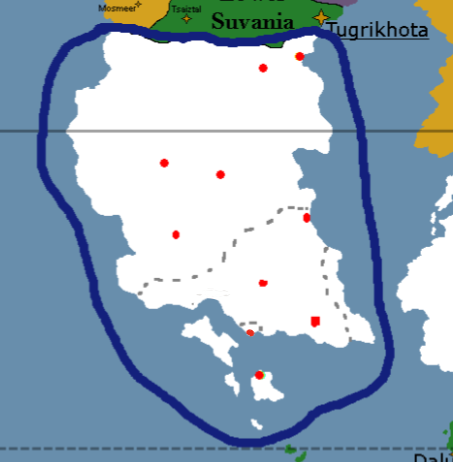Nation Name (long): Federal Republic of Istranta
Nation Name (short): Istranta
Population: 33,283,917 (2020 estimate)
Total GDP: $143,020,991,349
GDP per Capita: $4,297
Currency: Makra
Demonym: Istranti
Language(s): Istranti
Species: Elves and Humans
Capital: Kavarno
Largest City: Kavarno
Government Type: Federal dominant-party presidential republic under an authoritarian dictatorship
Leader: President Ardan Fitrevak
Legislature: Grand Assembly, bicameral
Upper House: Senatorial Assembly
Lower House: National Assembly
Two-Letter Code: IT
Three-Letter Code: ITA
Motto: We are all people
Historical Summary: Istranti history begins as various civilizations developing across its modern day territory, with the most state organization occurring in a concentrated region along the northeast coast and more spread out in the southern half of the territory, with much of the northern interior being characterized by pastoralist societies and trade routes rather than state development, save for a few exceptions. The 1200s sees the emergence of the powerful monarchical state of Norasajan in the southeast, the largest unified entity seen by the territory till that point. In the north, the city of Kavarno, ruled by an aristocratic elite emerges as a leading power, forming a confederation of cities against the threat of the short lived Alvan Empire and the Alvan raids that follow. Through the 1400s and 1500s, Nosarajan expands northwards into the drylands, taking control of the trade routes and marking the end of pastoral domination in the north, while the northern confederation is beset with internal disputes and eventually fractures, through Kavarno retains a prominent role in the politics of the region. Over the 1600s, Norasajan sees a drawn out decline due to internal divisions and continued conflict with the remaining states of the far north, and eventually collapses in the early 1700s. In the mid-late 1700s, Kavarno, now under the much more centralized rule of the Narcai family, consolidates the northeast under its rule. In the 1800s, partially due to the perceived need to develop a stronger power base in the face of Vistari and Suvani imperial expansion, Kavarno begins conquering the various states to the south, a process that takes decades to complete, as well as experiencing internal administrative shifts that formalize the state into a monarchy. In the north, this sparks heavy resistance from republican groups and eventually the outbreak of numerous domestic conflicts throughout the late 1800s and the eventual establishment of a republic, albeit one with significant political disparities rather than egalitarian power distribution. These ideological distinctions mean little, however, for the conquered south, with those in the conquered territories being treated as second-class citizens by monarchist and republican governance alike. Beginning under monarchist rule and continuing into republican rule, the core regions around Kavarno develop a highly repressive and exploitative relationship with the resource rich south, partially justified through ethnic differences between the north and the south. In the early 1900s, these differences materialized into an array of nonviolent and violent resistance movements, the latter of which sharply grew to prominence after numerous acts of military repression during the late 1930s. This led to a protracted civil war from the 1940s to the 1970s in which the state, centralized in the north, came into conflict with numerous armed resistance groups across the Istranti south, eventually concluding with the establishment of numerous autonomous zones in the south, in which local populations have a significantly increased degree of self-governance. The 1980s saw the rise of the Istranta United party, which has been continually in power since then, and the 1990s began to see a process of democratic backsliding, which rapidly accelerated in the early 2000s as Ardan Fitrevak rose to power and consolidated his rule. By the 2010s, Istranta had practically lost all of its democratic character, and the 2010s also saw efforts by the central government to reassert power in the autonomous zones. In 2023, the exercise of direct military force in autonomous territory led to the reignition of civil war in the country.
Cities, from northernmost to southernmost:
Kavarno
Tenarro
Surku
Kirgan
Daviranasa
Taveshar
Antuparadhan
Barnasidh
Ornassa
Pikatarn
Area within the dotted lines (does not include the islands) labeled Norasasi Autonomous Zones

